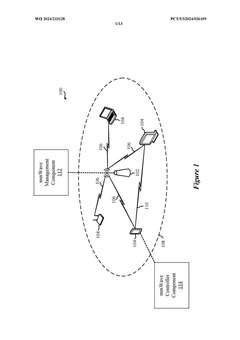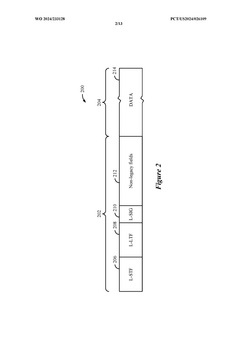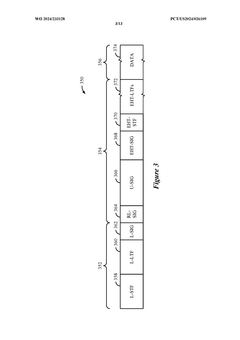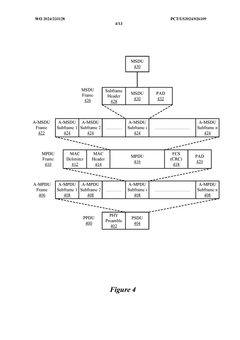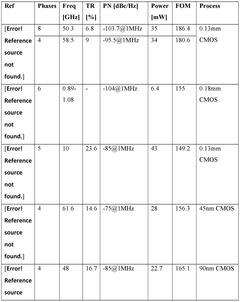How to Reduce Power Consumption in mmWave Systems
SEP 22, 20259 MIN READ
Generate Your Research Report Instantly with AI Agent
Patsnap Eureka helps you evaluate technical feasibility & market potential.
mmWave Power Efficiency Background and Objectives
Millimeter wave (mmWave) technology has emerged as a cornerstone for next-generation wireless communication systems, particularly in 5G and beyond. Operating in frequency bands between 30 GHz and 300 GHz, mmWave systems offer substantial bandwidth advantages that enable multi-gigabit data rates essential for applications ranging from high-definition video streaming to autonomous vehicles and industrial automation. However, the evolution of this technology has been consistently challenged by power consumption concerns that threaten its widespread adoption.
The historical development of mmWave systems traces back to early radar applications in the mid-20th century, with significant advancements occurring in the 1990s and 2000s as semiconductor technologies matured. The transition from primarily military and specialized applications to commercial telecommunications represents a pivotal shift in the technology's trajectory. This evolution has been accompanied by persistent efforts to address the inherent power efficiency limitations that characterize high-frequency operations.
Power consumption in mmWave systems stems from multiple sources, including signal generation, amplification, modulation, and beamforming processes. The physics of high-frequency operation introduces fundamental challenges, as circuit components operating at mmWave frequencies typically exhibit lower efficiency compared to their lower-frequency counterparts. Additionally, the propagation characteristics of mmWave signals—notably their susceptibility to atmospheric absorption and limited penetration capabilities—necessitate sophisticated antenna arrays and signal processing techniques that further increase power demands.
Recent technological trends indicate growing interest in energy-efficient mmWave solutions across various sectors. The mobile industry has been particularly vocal about the need for power-efficient mmWave implementations to enable practical battery-powered devices. Similarly, the satellite communication sector and emerging Internet of Things (IoT) applications are driving demand for low-power mmWave technologies that can operate within strict energy constraints.
The primary objective of this technical research is to comprehensively investigate approaches to reduce power consumption in mmWave systems without compromising performance metrics such as data rate, coverage, and reliability. Specifically, we aim to identify and evaluate innovative circuit designs, system architectures, and algorithmic solutions that address power efficiency challenges across the entire mmWave communication chain.
Secondary objectives include quantifying the potential power savings achievable through various optimization techniques, assessing the trade-offs between power consumption and system performance, and establishing a roadmap for future research directions. This investigation will consider both evolutionary improvements to existing technologies and revolutionary approaches that may fundamentally alter the power consumption paradigm in mmWave systems.
The historical development of mmWave systems traces back to early radar applications in the mid-20th century, with significant advancements occurring in the 1990s and 2000s as semiconductor technologies matured. The transition from primarily military and specialized applications to commercial telecommunications represents a pivotal shift in the technology's trajectory. This evolution has been accompanied by persistent efforts to address the inherent power efficiency limitations that characterize high-frequency operations.
Power consumption in mmWave systems stems from multiple sources, including signal generation, amplification, modulation, and beamforming processes. The physics of high-frequency operation introduces fundamental challenges, as circuit components operating at mmWave frequencies typically exhibit lower efficiency compared to their lower-frequency counterparts. Additionally, the propagation characteristics of mmWave signals—notably their susceptibility to atmospheric absorption and limited penetration capabilities—necessitate sophisticated antenna arrays and signal processing techniques that further increase power demands.
Recent technological trends indicate growing interest in energy-efficient mmWave solutions across various sectors. The mobile industry has been particularly vocal about the need for power-efficient mmWave implementations to enable practical battery-powered devices. Similarly, the satellite communication sector and emerging Internet of Things (IoT) applications are driving demand for low-power mmWave technologies that can operate within strict energy constraints.
The primary objective of this technical research is to comprehensively investigate approaches to reduce power consumption in mmWave systems without compromising performance metrics such as data rate, coverage, and reliability. Specifically, we aim to identify and evaluate innovative circuit designs, system architectures, and algorithmic solutions that address power efficiency challenges across the entire mmWave communication chain.
Secondary objectives include quantifying the potential power savings achievable through various optimization techniques, assessing the trade-offs between power consumption and system performance, and establishing a roadmap for future research directions. This investigation will consider both evolutionary improvements to existing technologies and revolutionary approaches that may fundamentally alter the power consumption paradigm in mmWave systems.
Market Demand for Low-Power mmWave Solutions
The millimeter wave (mmWave) technology market is experiencing significant growth driven by increasing demand for high-speed wireless communication, autonomous vehicles, and advanced sensing applications. According to recent market analyses, the global mmWave technology market is projected to reach $7.2 billion by 2026, growing at a CAGR of 35.2% from 2021. However, power consumption remains a critical challenge that limits broader adoption across various sectors.
The telecommunications industry represents the largest market segment demanding low-power mmWave solutions. With the global rollout of 5G networks, mobile network operators are seeking energy-efficient mmWave systems to reduce operational costs and meet sustainability goals. Current 5G base stations utilizing mmWave technology consume approximately 3-4 times more power than their 4G counterparts, creating significant pressure for power optimization solutions.
Consumer electronics manufacturers constitute another major market segment driving demand for power-efficient mmWave systems. As smartphones, tablets, and wearable devices increasingly incorporate mmWave capabilities for enhanced connectivity, battery life preservation becomes paramount. Market research indicates that consumers consistently rank battery life among the top three purchasing considerations for mobile devices, highlighting the commercial importance of power efficiency.
The automotive sector presents a rapidly expanding market for low-power mmWave solutions, particularly for advanced driver assistance systems (ADAS) and autonomous driving applications. Vehicle manufacturers are integrating multiple mmWave radar sensors for functions like adaptive cruise control, collision avoidance, and parking assistance. The power budget constraints in vehicles, especially electric vehicles where energy efficiency directly impacts range, create strong demand for low-power mmWave radar systems.
Healthcare applications represent an emerging market segment with specific requirements for power-efficient mmWave technology. Portable medical devices, remote patient monitoring systems, and wearable health trackers utilizing mmWave sensing technology must operate for extended periods without recharging. The global medical wearables market is expected to reach $19.5 billion by 2025, with power efficiency being a key differentiator for competitive products.
Industrial IoT applications are driving demand for low-power mmWave solutions in factory automation, asset tracking, and predictive maintenance systems. These applications often require sensors to operate for years on battery power or through energy harvesting, creating stringent power consumption requirements for mmWave systems. Market analysts predict that industrial IoT deployments will exceed 12.3 billion connected devices by 2025, many requiring power-efficient sensing and communication capabilities.
The telecommunications industry represents the largest market segment demanding low-power mmWave solutions. With the global rollout of 5G networks, mobile network operators are seeking energy-efficient mmWave systems to reduce operational costs and meet sustainability goals. Current 5G base stations utilizing mmWave technology consume approximately 3-4 times more power than their 4G counterparts, creating significant pressure for power optimization solutions.
Consumer electronics manufacturers constitute another major market segment driving demand for power-efficient mmWave systems. As smartphones, tablets, and wearable devices increasingly incorporate mmWave capabilities for enhanced connectivity, battery life preservation becomes paramount. Market research indicates that consumers consistently rank battery life among the top three purchasing considerations for mobile devices, highlighting the commercial importance of power efficiency.
The automotive sector presents a rapidly expanding market for low-power mmWave solutions, particularly for advanced driver assistance systems (ADAS) and autonomous driving applications. Vehicle manufacturers are integrating multiple mmWave radar sensors for functions like adaptive cruise control, collision avoidance, and parking assistance. The power budget constraints in vehicles, especially electric vehicles where energy efficiency directly impacts range, create strong demand for low-power mmWave radar systems.
Healthcare applications represent an emerging market segment with specific requirements for power-efficient mmWave technology. Portable medical devices, remote patient monitoring systems, and wearable health trackers utilizing mmWave sensing technology must operate for extended periods without recharging. The global medical wearables market is expected to reach $19.5 billion by 2025, with power efficiency being a key differentiator for competitive products.
Industrial IoT applications are driving demand for low-power mmWave solutions in factory automation, asset tracking, and predictive maintenance systems. These applications often require sensors to operate for years on battery power or through energy harvesting, creating stringent power consumption requirements for mmWave systems. Market analysts predict that industrial IoT deployments will exceed 12.3 billion connected devices by 2025, many requiring power-efficient sensing and communication capabilities.
Current State and Challenges in mmWave Power Consumption
Millimeter wave (mmWave) technology has emerged as a critical component in next-generation wireless communication systems, particularly in 5G and beyond. However, the current state of mmWave systems faces significant challenges related to power consumption. Traditional mmWave transceivers typically consume between 500mW to several watts of power, making them unsuitable for many battery-powered applications and raising concerns about energy efficiency in large-scale deployments.
The primary power consumption bottlenecks in current mmWave systems stem from several key components. Power amplifiers (PAs) represent the most significant power drain, consuming approximately 30-40% of the total system power while operating at relatively low efficiency (typically 10-20% at mmWave frequencies). This inefficiency is largely due to the inherent limitations of semiconductor technologies at high frequencies and the linearity requirements for advanced modulation schemes.
Analog-to-digital converters (ADCs) and digital-to-analog converters (DACs) constitute another major source of power consumption, particularly in wideband systems that require high sampling rates and resolution. Current high-speed ADCs operating at mmWave bandwidths can consume hundreds of milliwatts alone, scaling almost linearly with bandwidth and exponentially with resolution bits.
Phase shifters and other RF front-end components in beamforming architectures also contribute significantly to the overall power budget. The need for precise phase control across multiple antenna elements necessitates complex circuitry that consumes substantial power, especially in massive MIMO implementations where dozens or hundreds of antenna elements may be employed.
Geographically, the development of power-efficient mmWave technologies is concentrated primarily in North America, East Asia, and Europe. Companies and research institutions in the United States, South Korea, Japan, China, and several European countries are at the forefront of addressing these challenges, with varying approaches and priorities based on regional market demands and regulatory environments.
The technical constraints limiting power efficiency improvements include fundamental physics challenges related to semiconductor performance at high frequencies, thermal management issues in compact form factors, and the inherent trade-offs between power consumption and performance metrics such as bandwidth, noise figure, and linearity. Silicon-based technologies (CMOS, SiGe BiCMOS) struggle with efficiency at mmWave frequencies, while III-V compound semiconductors offer better performance but at higher cost and integration challenges.
Recent benchmarks indicate that state-of-the-art mmWave systems for mobile applications target power consumption below 200mW per RF chain, though actual implementations often exceed this figure. For fixed wireless access and infrastructure applications, power budgets are less constrained but still represent a significant operational cost and design challenge.
The primary power consumption bottlenecks in current mmWave systems stem from several key components. Power amplifiers (PAs) represent the most significant power drain, consuming approximately 30-40% of the total system power while operating at relatively low efficiency (typically 10-20% at mmWave frequencies). This inefficiency is largely due to the inherent limitations of semiconductor technologies at high frequencies and the linearity requirements for advanced modulation schemes.
Analog-to-digital converters (ADCs) and digital-to-analog converters (DACs) constitute another major source of power consumption, particularly in wideband systems that require high sampling rates and resolution. Current high-speed ADCs operating at mmWave bandwidths can consume hundreds of milliwatts alone, scaling almost linearly with bandwidth and exponentially with resolution bits.
Phase shifters and other RF front-end components in beamforming architectures also contribute significantly to the overall power budget. The need for precise phase control across multiple antenna elements necessitates complex circuitry that consumes substantial power, especially in massive MIMO implementations where dozens or hundreds of antenna elements may be employed.
Geographically, the development of power-efficient mmWave technologies is concentrated primarily in North America, East Asia, and Europe. Companies and research institutions in the United States, South Korea, Japan, China, and several European countries are at the forefront of addressing these challenges, with varying approaches and priorities based on regional market demands and regulatory environments.
The technical constraints limiting power efficiency improvements include fundamental physics challenges related to semiconductor performance at high frequencies, thermal management issues in compact form factors, and the inherent trade-offs between power consumption and performance metrics such as bandwidth, noise figure, and linearity. Silicon-based technologies (CMOS, SiGe BiCMOS) struggle with efficiency at mmWave frequencies, while III-V compound semiconductors offer better performance but at higher cost and integration challenges.
Recent benchmarks indicate that state-of-the-art mmWave systems for mobile applications target power consumption below 200mW per RF chain, though actual implementations often exceed this figure. For fixed wireless access and infrastructure applications, power budgets are less constrained but still represent a significant operational cost and design challenge.
Existing Power Reduction Strategies for mmWave Systems
01 Power management techniques for mmWave systems
Various power management techniques are employed in mmWave systems to optimize power consumption. These include dynamic power adjustment based on operational requirements, sleep modes during inactive periods, and intelligent power allocation across system components. Advanced algorithms monitor system performance and adjust power levels accordingly, ensuring efficient operation while maintaining required performance levels.- Power management techniques for mmWave systems: Various power management techniques are employed in mmWave systems to optimize power consumption. These include dynamic power adjustment based on operational requirements, sleep modes during inactive periods, and intelligent power allocation across system components. Advanced algorithms monitor system performance and adjust power levels accordingly, ensuring efficient operation while maintaining required performance levels.
- Energy-efficient mmWave transceiver designs: Energy-efficient transceiver designs for mmWave systems incorporate specialized circuit architectures and components that minimize power consumption. These designs include low-power amplifiers, efficient modulation schemes, and optimized RF front-end configurations. By reducing the power requirements of critical components while maintaining signal integrity, these transceivers achieve significant improvements in overall system energy efficiency.
- Beamforming and antenna array optimization for power efficiency: Beamforming techniques and antenna array optimizations play a crucial role in reducing power consumption in mmWave systems. By focusing signal energy in specific directions rather than broadcasting omnidirectionally, these systems can achieve the same coverage and data rates with lower transmit power. Adaptive beamforming algorithms further enhance efficiency by dynamically adjusting beam patterns based on user locations and channel conditions.
- Thermal management solutions for mmWave systems: Effective thermal management is essential for controlling power consumption in mmWave systems. Solutions include advanced heat dissipation techniques, thermal-aware circuit designs, and temperature monitoring systems. These approaches prevent performance degradation due to overheating, which would otherwise require additional power to maintain operation. Proper thermal management extends component lifespan and ensures consistent performance under varying environmental conditions.
- System-level power optimization strategies: System-level approaches to power optimization in mmWave systems involve coordinated management across multiple components and subsystems. These strategies include network-level load balancing, traffic-aware resource allocation, and cross-layer optimization techniques. By considering the entire system holistically, these approaches identify opportunities for power savings that might not be apparent when optimizing individual components in isolation, resulting in significant overall efficiency improvements.
02 Energy-efficient mmWave transceiver designs
Energy-efficient transceiver designs for mmWave systems incorporate specialized circuit architectures and components to minimize power consumption. These designs include low-power amplifiers, energy-efficient modulation schemes, and optimized RF front-end configurations. By reducing the power requirements of key components while maintaining signal integrity, these designs significantly improve the overall energy efficiency of mmWave communication systems.Expand Specific Solutions03 Beamforming and antenna array optimization for power efficiency
Beamforming techniques and antenna array optimizations are implemented to enhance power efficiency in mmWave systems. By focusing signal energy in specific directions rather than broadcasting omnidirectionally, these approaches reduce the power needed for effective communication. Adaptive beamforming algorithms dynamically adjust beam patterns based on channel conditions and user locations, further optimizing power usage while maintaining high data rates and coverage.Expand Specific Solutions04 Thermal management solutions for mmWave systems
Thermal management solutions address heat dissipation challenges in mmWave systems, which directly impacts power consumption. These solutions include advanced cooling techniques, thermal-aware component placement, and materials with superior thermal conductivity. By effectively managing heat, these approaches prevent performance degradation that would otherwise require increased power consumption, while also extending component lifespan and improving system reliability.Expand Specific Solutions05 Network-level power optimization for mmWave deployments
Network-level optimizations for mmWave deployments focus on system-wide power efficiency. These include intelligent resource allocation, traffic-aware network planning, and coordinated multi-point transmission strategies. Dynamic network reconfiguration based on traffic patterns and user density allows for portions of the network to be powered down during low-demand periods. These approaches collectively reduce the overall power consumption of mmWave network infrastructures while maintaining quality of service.Expand Specific Solutions
Key Industry Players in Low-Power mmWave Technology
The mmWave power consumption reduction market is currently in a growth phase, with increasing demand driven by 5G deployment and IoT applications. Major telecommunications equipment providers like Huawei, Ericsson, Nokia, and ZTE are leading technological innovation alongside semiconductor giants Qualcomm, Intel, NXP, and MediaTek. The market is characterized by intense competition between established players and emerging specialists, with research institutions like Southeast University and Cornell University contributing significant advancements. Technology maturity varies across applications, with consumer device implementations more mature than infrastructure solutions. Companies are focusing on architectural innovations, advanced semiconductor processes, and AI-based power management techniques to address the critical challenge of balancing high-frequency performance with energy efficiency in next-generation wireless systems.
Huawei Technologies Co., Ltd.
Technical Solution: Huawei has implemented a multi-faceted approach to reducing power consumption in mmWave systems through their MetaAAU (Active Antenna Unit) technology. Their solution incorporates extremely large-scale antenna arrays (ELAA) with intelligent beam management that can reduce the total power consumption by up to 30% compared to conventional systems. Huawei's PowerStar solution applies AI algorithms to predict traffic patterns and dynamically adjust the power state of mmWave components, achieving up to 15% additional power savings during low-traffic periods. The company has also developed specialized CMOS power amplifiers for mmWave frequencies that achieve 20-25% higher efficiency than traditional designs. Their system architecture implements cell-specific sleep modes that can deactivate portions of the mmWave array while maintaining coverage through sub-6GHz connectivity[2][5]. Huawei's approach also includes advanced thermal management techniques that reduce cooling requirements, further decreasing the overall system power consumption.
Strengths: Comprehensive end-to-end solution covering both device and infrastructure sides of mmWave deployment. Strong integration with AI for predictive power management. Weaknesses: Limited availability in some markets due to geopolitical restrictions, and solutions may require full Huawei ecosystem adoption for maximum efficiency.
QUALCOMM, Inc.
Technical Solution: Qualcomm has developed comprehensive solutions for reducing power consumption in mmWave systems through their Snapdragon X65 and X70 5G modem-RF systems. Their approach includes adaptive beamforming techniques that dynamically adjust the number of active antenna elements based on signal conditions, significantly reducing power requirements during normal operation. Qualcomm's QTM535 mmWave antenna module incorporates advanced power management circuitry that enables up to 30% lower power consumption compared to previous generations. Their technology implements intelligent sleep modes that can rapidly transition between active and low-power states within microseconds, maintaining connectivity while minimizing energy usage. Additionally, Qualcomm has pioneered dual-connectivity power-saving techniques that intelligently switch between sub-6GHz and mmWave bands based on throughput requirements and battery status[1][3].
Strengths: Industry-leading integration of modem and RF systems enables holistic power optimization across the entire signal chain. Extensive deployment experience provides real-world validation of power-saving techniques. Weaknesses: Solutions are primarily focused on mobile devices rather than infrastructure, and their proprietary nature can limit adoption in open ecosystems.
Critical Technologies for mmWave Power Efficiency
Multi-receive mode millimeter wave (mmwave) operation
PatentWO2024233128A1
Innovation
- Implementing a multi-receive mode operation in wireless communication devices that switch between sub-7 GHz and mmWave frequency spectra based on a multi-user request to send (MU-RTS) message, allowing for reduced power consumption by activating only necessary RF chains for data reception, thereby optimizing power usage and spectrum utilization.
Low power millimeter wave multi-phase inductor-coupled ring oscillator
PatentWO2025082584A1
Innovation
- The development of a low power millimeter wave (mmWave) multi-phase inductor-coupled ring oscillator that utilizes passive components to create phase differences, reducing noise and complexity, while achieving sub-mW power consumption through a simple topology with single differential inductors and two single-stage active delay cells.
Thermal Management Considerations for mmWave Devices
Thermal management represents a critical aspect of mmWave system design that directly impacts power consumption and overall system performance. As mmWave devices operate at higher frequencies (typically 30-300 GHz), they generate significant heat due to increased power density in compact form factors. This thermal challenge is exacerbated by the integration of multiple radio frequency (RF) components, digital processing units, and power amplifiers within limited spaces.
The relationship between thermal management and power consumption forms a critical feedback loop. Higher operating temperatures increase leakage currents in semiconductor devices, which in turn elevates power consumption. This additional power dissipation further increases device temperature, potentially triggering thermal runaway conditions that compromise reliability and performance.
Advanced thermal management solutions for mmWave systems include both passive and active cooling techniques. Passive approaches utilize specialized thermal interface materials (TIMs), heat spreaders, and optimized PCB designs with enhanced thermal vias. These solutions facilitate efficient heat dissipation without requiring additional power input, making them particularly valuable for power-constrained applications.
Active cooling mechanisms, including micro-fans, thermoelectric coolers, and liquid cooling systems, offer more aggressive thermal management but introduce additional power requirements. The design challenge lies in balancing cooling effectiveness against the power overhead these systems introduce. In many cases, hybrid approaches combining passive and selective active cooling yield optimal results.
Thermal simulation and modeling have become essential tools in mmWave system design. Computational fluid dynamics (CFD) and finite element analysis enable designers to identify hotspots and optimize thermal pathways before physical prototyping. These simulation approaches help minimize design iterations and ensure thermal management solutions address specific system requirements.
Material innovation plays a significant role in advancing thermal management capabilities. Novel materials such as synthetic diamond heat spreaders, graphene-based thermal interfaces, and advanced ceramic substrates offer superior thermal conductivity compared to traditional materials. These innovations enable more efficient heat dissipation without increasing system size or weight.
Temperature-aware power management algorithms represent another frontier in thermal optimization. These intelligent systems dynamically adjust operating parameters based on thermal conditions, potentially reducing clock speeds or selectively disabling components during periods of thermal stress. Such adaptive approaches maintain system reliability while minimizing unnecessary power consumption.
The relationship between thermal management and power consumption forms a critical feedback loop. Higher operating temperatures increase leakage currents in semiconductor devices, which in turn elevates power consumption. This additional power dissipation further increases device temperature, potentially triggering thermal runaway conditions that compromise reliability and performance.
Advanced thermal management solutions for mmWave systems include both passive and active cooling techniques. Passive approaches utilize specialized thermal interface materials (TIMs), heat spreaders, and optimized PCB designs with enhanced thermal vias. These solutions facilitate efficient heat dissipation without requiring additional power input, making them particularly valuable for power-constrained applications.
Active cooling mechanisms, including micro-fans, thermoelectric coolers, and liquid cooling systems, offer more aggressive thermal management but introduce additional power requirements. The design challenge lies in balancing cooling effectiveness against the power overhead these systems introduce. In many cases, hybrid approaches combining passive and selective active cooling yield optimal results.
Thermal simulation and modeling have become essential tools in mmWave system design. Computational fluid dynamics (CFD) and finite element analysis enable designers to identify hotspots and optimize thermal pathways before physical prototyping. These simulation approaches help minimize design iterations and ensure thermal management solutions address specific system requirements.
Material innovation plays a significant role in advancing thermal management capabilities. Novel materials such as synthetic diamond heat spreaders, graphene-based thermal interfaces, and advanced ceramic substrates offer superior thermal conductivity compared to traditional materials. These innovations enable more efficient heat dissipation without increasing system size or weight.
Temperature-aware power management algorithms represent another frontier in thermal optimization. These intelligent systems dynamically adjust operating parameters based on thermal conditions, potentially reducing clock speeds or selectively disabling components during periods of thermal stress. Such adaptive approaches maintain system reliability while minimizing unnecessary power consumption.
Standardization Efforts in Energy-Efficient mmWave Communications
The standardization landscape for energy-efficient mmWave communications has evolved significantly in recent years, with several international bodies establishing frameworks to address power consumption challenges. The IEEE 802.11ad/ay standards have pioneered energy efficiency protocols for 60 GHz communications, introducing power-saving mechanisms such as spatial multiplexing optimization and beamforming coordination that reduce active transmission periods while maintaining throughput requirements.
The 3GPP has incorporated energy efficiency as a key performance indicator in its 5G NR specifications (Release 15 and beyond), with specific provisions for mmWave bands (FR2). These standards define sleep modes, discontinuous reception (DRX) parameters, and beam management procedures optimized for power conservation. The energy efficiency working group within 3GPP has established measurement methodologies that quantify power consumption relative to data throughput, creating benchmarks for equipment manufacturers.
ETSI's millimeter wave transmission group (mWT) has developed the GS mWT 008 specification focusing on energy efficiency metrics and requirements for backhaul and fronthaul applications. This standard provides a framework for evaluating power consumption across different operational scenarios and environmental conditions, enabling fair comparison between vendor implementations.
The International Telecommunication Union (ITU) has published recommendations under the ITU-T L.1310 series that address energy efficiency requirements for radio access network equipment, including specific considerations for mmWave systems. These recommendations establish power consumption limits and measurement methodologies that are increasingly being adopted by regulatory bodies worldwide.
Industry consortiums like the NGMN Alliance and O-RAN Alliance have established working groups dedicated to energy efficiency in next-generation networks. Their technical specifications include reference architectures for intelligent power management in mmWave systems, with standardized interfaces for energy-aware network orchestration and dynamic resource allocation.
Emerging standardization efforts are focusing on cross-layer optimization approaches, where hardware-level power management is coordinated with higher-layer protocols. The Small Cell Forum has published specifications for energy-efficient mmWave small cells that incorporate AI-driven power management techniques, while the Telecom Infra Project (TIP) is developing open standards for energy-efficient mmWave equipment that can adapt power consumption based on traffic patterns and service requirements.
These standardization initiatives collectively provide a comprehensive framework for addressing power consumption challenges in mmWave systems, enabling interoperability while driving industry-wide improvements in energy efficiency.
The 3GPP has incorporated energy efficiency as a key performance indicator in its 5G NR specifications (Release 15 and beyond), with specific provisions for mmWave bands (FR2). These standards define sleep modes, discontinuous reception (DRX) parameters, and beam management procedures optimized for power conservation. The energy efficiency working group within 3GPP has established measurement methodologies that quantify power consumption relative to data throughput, creating benchmarks for equipment manufacturers.
ETSI's millimeter wave transmission group (mWT) has developed the GS mWT 008 specification focusing on energy efficiency metrics and requirements for backhaul and fronthaul applications. This standard provides a framework for evaluating power consumption across different operational scenarios and environmental conditions, enabling fair comparison between vendor implementations.
The International Telecommunication Union (ITU) has published recommendations under the ITU-T L.1310 series that address energy efficiency requirements for radio access network equipment, including specific considerations for mmWave systems. These recommendations establish power consumption limits and measurement methodologies that are increasingly being adopted by regulatory bodies worldwide.
Industry consortiums like the NGMN Alliance and O-RAN Alliance have established working groups dedicated to energy efficiency in next-generation networks. Their technical specifications include reference architectures for intelligent power management in mmWave systems, with standardized interfaces for energy-aware network orchestration and dynamic resource allocation.
Emerging standardization efforts are focusing on cross-layer optimization approaches, where hardware-level power management is coordinated with higher-layer protocols. The Small Cell Forum has published specifications for energy-efficient mmWave small cells that incorporate AI-driven power management techniques, while the Telecom Infra Project (TIP) is developing open standards for energy-efficient mmWave equipment that can adapt power consumption based on traffic patterns and service requirements.
These standardization initiatives collectively provide a comprehensive framework for addressing power consumption challenges in mmWave systems, enabling interoperability while driving industry-wide improvements in energy efficiency.
Unlock deeper insights with Patsnap Eureka Quick Research — get a full tech report to explore trends and direct your research. Try now!
Generate Your Research Report Instantly with AI Agent
Supercharge your innovation with Patsnap Eureka AI Agent Platform!
